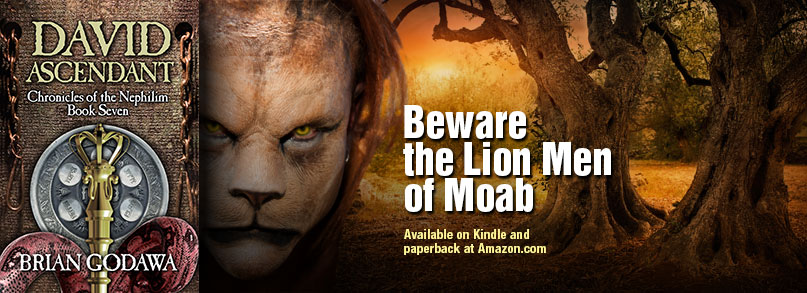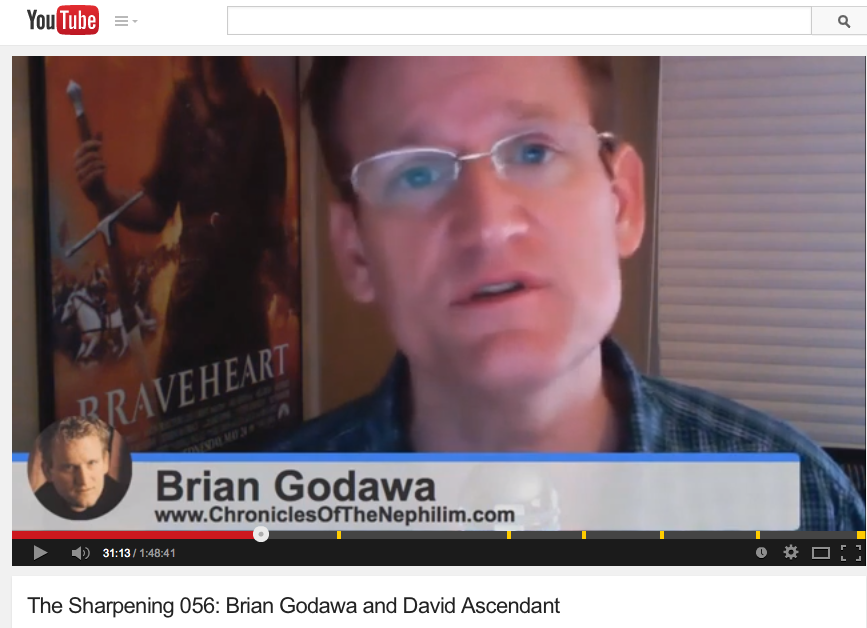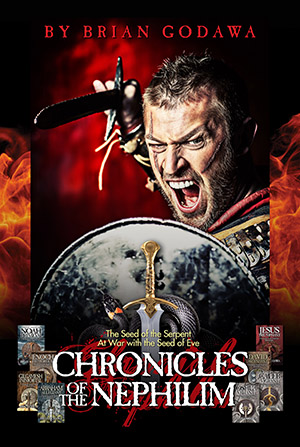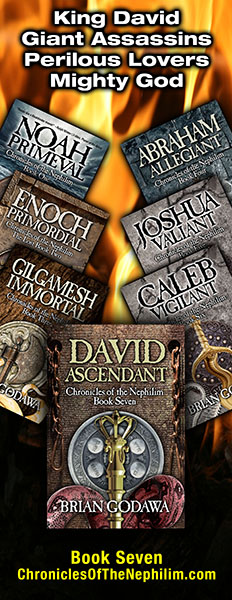
Another strange legendary creature shows up in the Bible that made it into my novel David Ascendant: Lion Men of Moab. In Hebrew, they are called Ariels. They are kind of like werewolves – but more like werelions.
In 2 Sam. 23:20 Benaiah, a valiant warrior, strikes down “two ariels of Moab.” The word “ariel” is a transliteration because scholars are not sure what it means. The King James and Young’s Bibles translate these opponents of Benaiah as “lion-like men of Moab,” which captures the strangeness of the creatures but fails to express the religious or supernatural connotation of the word.
Some translators translate the phrase “ariels of Moab” as “sons of Ariel of Moab” after the unlikely LXX Greek translation,[1] or “lion-like heroes of Moab.” But there is no Hebrew word for “sons of” in the sentence, no indication of ariel being a personal name, and no Hebrew word for warrior used in the sentence. The Hebrew word for mighty warrior, gibborim, is used frequently throughout David’s narrative and that word is not here. The text says “two ariels of Moab.”
Some suggest it may be a reference to killing two lions. But the very next sentence states that Benaiah, the killer of the ariels, then killed a lion in a pit.
2 Samuel 23:20
And Benaiah the son of Jehoiada was a valiant man of Kabzeel, a doer of great deeds. He struck down two ariels of Moab. He also went down and struck down a lion in a pit on a day when snow had fallen.
The Hebrew word for “lion” is not
ariel, but
aryeh. Adding the suffix “el” to the word adds a religious dimension of meaning that transcends mere lions. This is why Hebrew lexicons explain the most likely meaning as “lion of god.”
[2] El was not merely a name used of Yahweh in the Bible, it was the name of the figurehead deity of the Canaanite pantheon as well as a general reference to deity in Mesopotamia.
[3]In 1 Chronicles, some additional warriors from Gad join David when he is at Ziklag, and they are described exactly like
ariels as “lion-faced warriors” with preternatural skills:
1 Chronicles 12:8
8 From the Gadites there went over to David at the stronghold in the wilderness mighty and experienced warriors, expert with shield and spear, whose faces were like the faces of lions and who were swift as gazelles upon the mountains:
Though animal-like abilities is a common metaphor used to describe extraordinary warrior skills, having faces like the faces of lions could mean more in light of the existence of these ariels, or Lion Men of Moab. Since the tribal location of Gad was precisely all the land of Moab across the Jordan, I decided to make the Gadite lion-faced men be those very Lion Men of Moab who converted to Israel and joined David. Two of these hybrid warriors then become the two traitors who face down Benaiah.
Psalm 57 was written when David was on the run and hiding out in a cave from Saul’s bounty hunters. Verse 4 says, “My soul is in the midst of lions; I lie down amid fiery beasts— the children of man, whose teeth are spears and arrows, whose tongues are sharp swords.” Though a surface reading of this text appears to be an obvious figurative expression of David’s enemies, scholar B. Mazar suggests it may be a reference to a mercenary military corps of archers whose emblem was the lion-goddess.[4] Could they have come from Moab?
So what if these ariels are hybrid creatures reminiscent of the Watchers’ miscegenation in Genesis 6? What if they are elite warriors with hairy bodies and lion-like faces that only one of David’s own gibborim Mighty Men could slay? After all, the exploits of those Mighty Men in the passages we have been looking at are supernatural slayings of giants and hundreds of soldiers by single warriors. If these ariels were mere warriors, then the feat accomplished by Benaiah in slaying them would be the only one in the entire passage that was banal and without significance.
These ariels were something more than men, something supernatural. The ancient understanding of ariel as a lion-like hybrid humanoid finds support in a later Nag Hammadi text that speaks of a gnostic deity, Yaldabaoth, who was an ariel (spelled slightly different): “Ariael is what the perfect call him, for he was like a lion.”[5]
The ancient understanding of ariel as a lion-like hybrid humanoid finds support in a later Nag Hammadi text that speaks of a gnostic deity, Yaldabaoth, who was an ariel (spelled slightly different): “Ariael is what the perfect call him, for he was like a lion.”[5]
The Dictionary of Deities and Demons in the Bible says of this possible religious mythical interpretation of ariel:
This interpretation could be supported by a recently found bronze-silver figurine from Tell Abū el-Kharaz in Transjordan representing, according to the excavator’s opinion a male lion-faced warrior(-god?), which can be viewed, because of its appearance and its attributes, as a male pendant.[6]
The author then reveals that the word ariel shows up in the Mesha Stele, a Moabite stone inscription not too long after the time of King David.[7] These are the very Moabites from which 2 Samuel says the ariels come. The line of text in question could be translated, “the lion figure [ariel] of their beloved (god)’ which was dragged before Chemosh after the fall of the Israelite city.”[8]
Bible scholar B. Mazar notes this Mesha Stele connection and adds that the word ariel became a synonym for the lion-headed cherubim at the base of kingly thrones.[9]
So in David Ascendant, I created a special unit of these Ariels, lion-headed warriors of Moab, to explore that supernatural dimension with imagination that fit the thread of the cosmic War of the Seed.
The ancient Book of Jasher was a source text for both Joshua and David’s stories (Josh. 10:13, 2 Sam. 1:18). The extant version we have of the Book of Jasher, though dubitable, tells of two different stories that contain hybrid creatures that may be similar to the lion-men of Moab or the satyrs of Banias. In Jasher 36:29-35 we read of Anah, one of the sons of Seir the Horite, (remember the Seirites’ connection to satyrs) during the days of Abraham. There is a large storm that the writer says caused a group of about 120 “great and terrible animals” to come out of the forest by the seashore to be witnessed by Anah feeding his asses.
Jasher 36:29-35
And those animals, from their middle downward, were in the shape of the children of men, and from their middle upward, some had the likeness of bears, and some the likeness of the keephas, with tails behind them from between their shoulders reaching down to the earth, like the tails of the ducheephath, and these animals came and mounted and rode upon these asses, and led them away, and they went away unto this day.
[10]
Another chapter in Jasher tells the story during the youth of Balaam son of Beor, about a strange animal that was devouring the cattle of the people of Chittim. A man named Zepho went in search of this creature and…
Jasher 61:15
he came into the cave and he looked and behold, a large animal was devouring the ox; from the middle upward it resembled a man, and from the middle downward it resembled an animal, and Zepho rose up against the animal and slew it with his swords.
[11]
Were these creatures mere legends or were they genetic hybrid remnants of the miscegenation of the Watchers?
Read about the Lion Men of Moab in the novel, David Ascendant, Book 7 of Chronicles of the Nephilim.
[1] “Although the LXX interferes seriously in the text, presupposing a double haplography in the Hebrew text, this reading points into the right direction. As a matter of fact NKH Hiphʿil in the historical books never means to strike upon an object (cf. also E. Jenni, ErIs 24 [1993] 114–118), but to strike down, i.e. to kill somebody… Consequently, Ariel here designates some kind of person, best translated as ‘lion of God’: S. Münger, “Ariel,” ed. Karel van der Toorn, Bob Becking, and Pieter W. van der Horst,
Dictionary of Deities and Demons in the Bible (Leiden; Boston; Köln; Grand Rapids, MI; Cambridge: Brill; Eerdmans, 1999), 88–89.
[2] Francis Brown, Samuel Rolles Driver and Charles Augustus Briggs,
Enhanced Brown-Driver-Briggs Hebrew and English Lexicon, electronic ed., 72 (Oak Harbor, WA: Logos Research Systems, 2000).
[3] W. Herrmann, “El,” ed. Karel van der Toorn, Bob Becking, and Pieter W. van der Horst, Dictionary of Deities and Demons in the Bible (Leiden; Boston; Köln; Grand Rapids, MI; Cambridge: Brill; Eerdmans, 1999), 275.
[4] B. Mazar, “The Military Élite of King David,”
Vetus Testamentum, Vol. 13, Fasc. 3 (Jul., 1963), 312.
[5] James McConkey Robinson, Richard Smith and Coptic Gnostic Library Project,
The Nag Hammadi Library in English, 4th rev. ed., 173 (Leiden; New York: E. J. Brill, 1996).
[6] S. Münger, “Ariel,” ed. Karel van der Toorn, Bob Becking, and Pieter W. van der Horst,
Dictionary of Deities and Demons in the Bible (Leiden; Boston; Köln; Grand Rapids, MI; Cambridge: Brill; Eerdmans, 1999), 89. Münger refers to the
Annual of the Department of Antiquities of Jordan (P. M. Fischer,
ADAJ 40 [1996] 101–110, esp. 103–104 with figs. 3a-b).
[8] S. Münger,
DDD, 89. Pritchard’s
Ancient Near Eastern Texts Relating to the Old Testament translates
ariel as the name of the king of the city, and Hallo’s Context of Scripture translates it as the more unlikely object,
fire hearth. James Bennett Pritchard, ed.,
The Ancient Near East an Anthology of Texts and Pictures, 3rd ed. with Supplement (Princeton: Princeton University Press, 1969), 320; William W. Hallo and K. Lawson Younger,
Context of Scripture (Leiden; Boston: Brill, 2000), 137.
[9] B. Mazar, “The Military Élite of King David,”
Vetus Testamentum, Vol. 13, Fasc. 3 (Jul., 1963), pp. 316.
[10] Johnson, Ken (2012-01-09).
Ancient Book Of Jasher (p. 129). Kindle Edition.
[11] Johnson,
Book Of Jasher (p. 223).


 The ancient understanding of ariel as a lion-like hybrid humanoid finds support in a later Nag Hammadi text that speaks of a gnostic deity, Yaldabaoth, who was an ariel (spelled slightly different): “Ariael is what the perfect call him, for he was like a lion.”
The ancient understanding of ariel as a lion-like hybrid humanoid finds support in a later Nag Hammadi text that speaks of a gnostic deity, Yaldabaoth, who was an ariel (spelled slightly different): “Ariael is what the perfect call him, for he was like a lion.”





